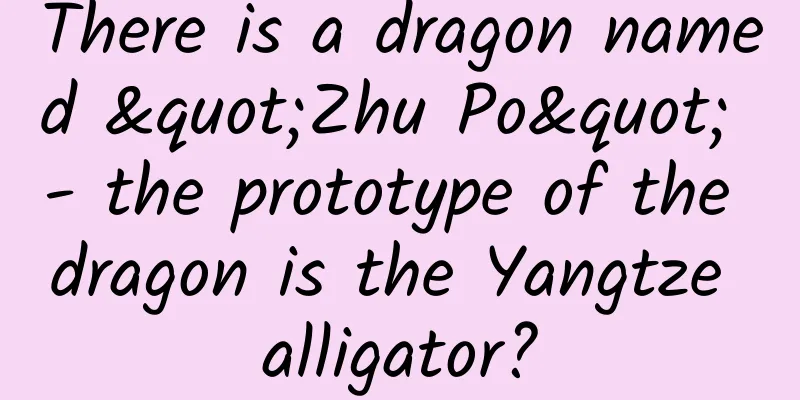There is a dragon named "Zhu Po" - the prototype of the dragon is the Yangtze alligator?

|
2024 is the Year of the Dragon in the lunar calendar. When you were a child, did you ever wonder: Do dragons really exist? As you grow up, you will have a definite answer in your heart. Because whether it is teachers or popular science books, magazines, or TV programs, they all tell you one thing: dragons are only animals in Chinese myths and legends, and do not exist in our real life. However, the dragon has left such a strong mark in Chinese history and traditional culture, and its image must not be groundless. In other words, it should at least have a prototype. The dragon is a big snake? You are too careless! What kind of animal is a dragon in the real world? Think back to the dragon patterns embroidered on the dragon robes of emperors of all dynasties, the little white dragon in "Journey to the West" who fought with Sun Wukong because he ate Tang Monk's white horse, and the dragon in the Japanese anime "Dragon Ball" that can be summoned after collecting 7 dragon balls and help people realize their wishes... In various legends, the dragon has a horse-like head, deer-like horns, dog-like claws, fish-like scales and whiskers, and a snake-like slender body... After seeing the image of a dragon, many people's first reaction is that the dragon should be a large snake "assembled" from the body parts of animals such as horses, deer, dogs, and fish. However, if you open the history books of my country, you will be surprised to find that snakes and dragons are two independent creatures! For example, the "Classic of Mountains and Seas" records that there are both snake-bodied beasts with human faces and human-bodied beasts with dragon heads; the "Zuo Zhuan" also records that when Emperor Shun was in power, dragons and snakes lived together in the swamps deep in the mountains. Image of dragon in "Ancient and Modern Books Collection"/Internet This leads to another view: the prototype of the dragon is the crocodile. Scholars who support this view have found a lot of relevant evidence to prove it, and further pointed out that the image of the dragon is likely to come from the rare crocodile unique to my country - the famous Yangtze alligator, which was also called tuó, tulong, and pig dragon in ancient times. The "Dragon" in Historical Mythology and the Yangtze Alligator in Reality ●The monster in the water is called a dragon. The Chinese alligator is a semi-aquatic animal. Looking through ancient books such as Zuo Zhuan and Guoyu, they seem to convey the same message to us in unison - dragons live in water. For example, Guoyu records that "the monster in the water is called a dragon". In later fantasy novels such as Journey to the West and Investiture of the Gods, the Dragon King and his sons and grandsons are also portrayed as aquatic creatures that guard rivers and lakes and overturn rivers and seas. Yangtze alligator photo/Visual China This is consistent with the semi-aquatic habits of the Chinese alligator. The Chinese alligator often digs holes near ponds, lakes, swamps, and riverbanks to live. In summer, the Chinese alligator often comes out of the hole to float on the water. When swimming in the water, the Chinese alligator may float with its head, or expose its back, or both, appearing and disappearing, which is very mysterious. ● Dragons with scales are called Jiaolong - the Yangtze alligator is covered with large horny scales The earliest dictionary in my country, Shuowen Jiezi (written in the Eastern Han Dynasty), says that dragon is "the leader of scaled insects", which means that among animals with scales, dragon ranks first. Also in the Eastern Han Dynasty, there is a record of "a dragon with scales is called a Jiaolong". During the Warring States Period, there was a more interesting saying: there is a scale growing upside down near the throat of a dragon - the reverse scale. Once it is touched, the dragon will get angry. The Japanese borrowed this allusion and set the "reverse scale" trick for the dragon Pokémon in the Pokémon game. In short, we can infer that the ancient Chinese believed that dragons had scales. The occipital scales behind the ears of an adult Chinese alligator look like horns from a distance. Photo from the Internet The neck, back and even the tail of the Chinese alligator are covered with huge scales made of keratin. The scales on the back of the Chinese alligator are particularly eye-catching. They are arranged vertically, have a hard texture, protrude outwards and have ridges, looking like a majestic scale armor. ● Dragon eggs were cut open in the mausoleum - the Chinese alligator is an oviparous animal Liu An, the grandson of Emperor Gaozu of Han, was a learned prince. He believed that "dragons lie in deep waters and lay their eggs on the ground." This sentence roughly means "dragons live in deep waters and lay their eggs on land." This shows that Liu An, a man in the Han Dynasty, believed that dragons lay eggs. Some people in the Jin Dynasty also said that dragons not only lay eggs, but also that the eggs are very large. It can be seen that the ancients believed that dragons reproduced by laying eggs. After mating with a male alligator, a female alligator will build a tower-shaped "nursery" on the shore with weeds and dead leaves. After the nest is built, the female alligator lays eggs in the nest, with an average of 20 eggs per nest. The eggs are arranged in 2 to 3 layers and covered with dead leaves and weeds to keep them warm. It must be said that this habit is strikingly similar to the description of dragons "hiding in the abyss and laying eggs in the hills". ● Jiao is like a snake but has four legs - the Chinese alligator has a slender body and looks like a big lizard In the Jin Dynasty, there was a man named Pei Yuan who believed that the dragon looked like a snake, but had four legs (a Jiao was more than ten feet long, like a snake but with four legs). His meaning was very clear - the dragon just looked like a snake, but it was not a snake, and because it had four legs, we might as well call it a "four-legged snake." This further confirmed that "the prototype of the dragon was not a snake." The Yangtze alligator has a slender body, with a flat rectangular trunk that is twice as long as its head. It looks like an oversized lizard, which is nicknamed "four-legged snake". ●The roar of a dragon is like a drum or thunder - the Chinese alligator can make a huge roar As early as in the Classic of Mountains and Seas, it was recorded that "there is a thunder god in Lei Ze, with a dragon body and a human head, and thunder will sound when he inflates his belly". This means that the "thunder god" with a dragon head can make a thunderous roar when he inflates his belly. In the Jin Dynasty, there was a record that "the alligator is good at making noises at night, and its noises are like drums", which means that the alligator (Yangtze alligator) likes to make loud noises at night, and its noises sound like drums. After the Yuan Dynasty, people in some places thought that this noise sounded a bit like the noise of a pig, so they simply called the Yangtze alligator "Pig Dragon" to be more down-to-earth. Although the Chinese alligator has no vocal cords, it has mastered two ways of making sounds: one is to use the air stored in the lungs to suddenly open the palatine velum and laryngeal folds when the mouth is open, and the other is to use the air in the lungs to open the nasal valve when the mouth is closed. Both methods can replace the vocal cords and make the Chinese alligator roar like thunder. We often say "the sound of drums is like thunder", and the sound of drums, thunder and pigs do have similarities. It seems that the crocodile dragon (Zhu Polong) is closely related to the "Thunder God" in the "Classic of Mountains and Seas". Alligators are everywhere in China: our "old neighbor" Yangtze alligator We can't help but exclaim, if the prototype of the dragon is really the Yangtze alligator, then this rare crocodile, which is now only distributed in parts of the lower reaches of the Yangtze River, has it been seen by so many people in different periods and regions in Chinese history? The Yangtze alligator can be considered an "old neighbor" of the Chinese people! According to the excavation results of paleontologists and archaeologists, from the Paleogene tens of millions of years ago to the Shang and Zhou dynasties more than 3,000 years ago, the Yangtze alligator was distributed in most of China - from Shanxi, Shaanxi, Henan, and Shandong on the banks of the Yellow River, to Hubei and Zhejiang on the banks of the Yangtze River, to Guangdong in southern China, and even near Taiwan. In addition to being scattered in the strata, some alligator remains are found in people's houses, and some are placed in people's tombs. People even use alligator skins to make drums - alligator drums! It must be said that the relationship between alligators and ancient people is very close! Case reversal: The prototype of the dragon is not the Yangtze alligator? In Chinese history, there are countless people who have "witnessed" dragons. According to the "Records of the Grand Historian", during the reign of King Kongjia of Xia, he once obtained a male dragon and a female dragon, and specially hired someone to raise the two dragons, and named them "Yulongshi". After the dragons died, Yulongshi made a meat soup with the dragon meat for Kongjia to taste. According to the "Zuo Zhuan", during the Spring and Autumn Period, there was a flood in Zheng State, and the people of Zheng saw dragons "fighting" in the river outside the city gate. Through the previous analysis, we know that the prototype of the dragon may be the Yangtze alligator, and we also know that the Yangtze alligator was once distributed in the Yellow River Basin. Therefore, the above "dragon mysteries" that occurred along the Yellow River are not difficult to explain. It seems that the prototype of the dragon is the Yangtze alligator, which can be concluded? ●【Character evidence】“龙” and “鼍” are completely different Obviously, there is a big difference between these two characters from the Shang Dynasty. Like you, I have a hard time convincing myself that these two characters represent the same animal... The "dragon" on the oracle bones of the Shang Dynasty and the "crocodile" on the hanging tortoise tripod of the late Shang Dynasty (Photo/Internet) ●【Physical evidence】“Dragon” and “Crocodile” are very different Coincidentally, there are two artifacts from the Shang Dynasty that depict different animals. The shape of the dragon-shaped jade is consistent with our impression of the image of a "dragon"; and the decoration on the bronze goblet, although many people say it is a dragon, we can clearly see that it should be a crocodile... Therefore, judging from the above written and physical evidence, not only is it doubtful that "the prototype of the dragon is the Yangtze alligator", but even "whether the prototype of the dragon is the crocodile" seems to be debatable. What kind of creature is a dragon? Perhaps it will always remain a mystery, but this is precisely the charm of Chinese dragon culture. Don't let the Chinese alligator become as mysterious as the dragon As we mentioned earlier, the Yangtze alligator was once found throughout most of China, but nowadays, wild Yangtze alligators are only found in parts of the lower reaches of the Yangtze River. The tragedy of the Yangtze alligator has a lot to do with human activities in history. As early as the Neolithic Age, the Chinese alligator was hunted by humans. For example, the ancestors in the Yellow River Basin used the skin of the Chinese alligator to make drums and ate its meat. Moreover, with the promotion of "iron plow and ox plowing" in agricultural production during the Spring and Autumn Period and the Warring States Period, the implementation of the "reclaiming wasteland" policy in the Song Dynasty, and the continuous increase in population since the Ming and Qing Dynasties, the habitat of the Chinese alligator has been shrinking due to the expansion of human activities. Although my country has made remarkable achievements in artificial breeding of Chinese alligators in recent years, the number of wild Chinese alligators is still rare and is still listed as a critically endangered species in the IUCN Red List of Threatened Species. It is urgent to protect and restore the wild population of Chinese alligators. Don't let them become as mysterious as dragons! By Zhai Guoqing |
>>: 7 eating habits that cancer cells love most. Check to see if you are one of them.
Recommend
The most comprehensive guide to attracting customers to Xiaohongshu
In the Internet community in 2019, while self-med...
2019 Kuaishou operation tips for increasing followers!
The predecessor of Kuaishou, called "GIF Kua...
How to write a good article title?
The author of the public account Caobian Wangshi,...
The most comprehensive analysis to date! Antibiotic resistance-related deaths have become the third leading cause of death worldwide
Written by: Zhu Hengheng Editor: Wang Haha Since ...
How much does it cost to customize a kitchen app in Baiyin?
How much does it cost to customize the Baiyin Kit...
Case Analysis | How to achieve “unity of knowledge and action” when writing a promotion plan?
Today we are going to talk about writing a planni...
Control the 5 stages of app marketing, how to promote apps, how to promote apps, and steps to promote apps
1. Overall Logic There is only one logic in runni...
Meituan Grocery APP Product Analysis
The growth of user scale and the maturity of deli...
The "fall" of Western Digital Blue Disk: it actually slowed down to 5400 rpm!
The "colorful" hard drives of Western D...
What are the functions of WeChat mini program of Guangzhou milk tea shop? How to set up WeChat mini program of Guangzhou milk tea shop?
After the Qingming Festival, the temperature bega...
iOS 17.0.1 battery life test results are out, and it crashes again!
A few days after the official release of iOS 17, ...
China Passenger Car Association: Automotive industry retail sales rankings in July 2022
According to the latest retail sales data from th...
In addition to the first wave of users who have the motivation to spread the word, you also need to know KOLs
Among the key communicators, in addition to the f...
Here are the 4 essential skills for new media writing!
The popularity of WeChat has also brought about a...
This bird has something to do with the brothel madam
In the past few days, three great bustards came t...









